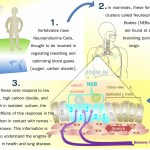breathing
Image of zebrafish By Pogrebnoj-Alexandroff from Wikimedia Commons
We tend to think of carbon monoxide (CO) only in terms of being a poisonous gas. The reason for its toxicity is due to its ability to bind really tightly to our hemoglobin molecules, which prevents oxygen from being able to bind. In mammals, CO also decrease breathing rate. As you can imagine, it is a pretty terrible gas to breath in when you are a species dependent on hemoglobin for delivery of oxygen to tissues.
Did you know that CO is also produced in our bodies when heme molecules are broken down by…
Here is a neat video that I watched at the David Bruce Undergraduate Poster session at the Experimental Biology conference last week. It describes the amazing physiology of the avian lung and was created by an undergraduate student researcher, Peter Luu for the Physiology Video Contest sponsored by the American Physiological Society. This video won the Viewer's Choice Award:
To see more of the submitted videos, visit the American Physiological Society website.
Congratulations to Nicolle Domnik, this year's winner of the new Dr. Dolittle Travel Award to present her research at the annual Experimental Biology conference in San Diego, CA in April. Nicolle is currently a graduate student in the Department of Biomedical and Molecular Sciences at Queen's University in Canada. The award criteria included the submission of a guest blog entry based on the research she will be presenting at the Experimental Biology conference (N Domnik, SG Vincent, E Cutz, JT Fisher. Murine airway slowly-adapting receptor responses to lung inflation: A role for serotonin?…
